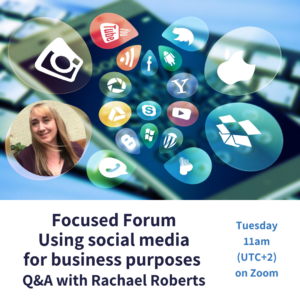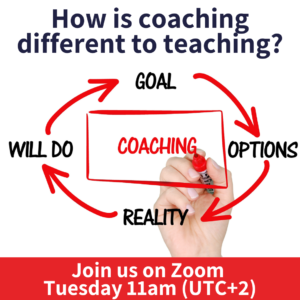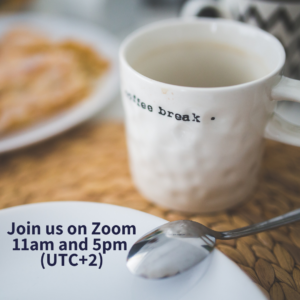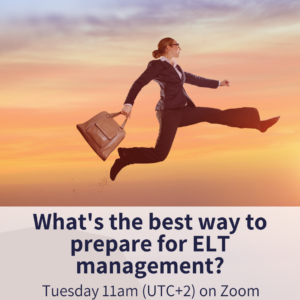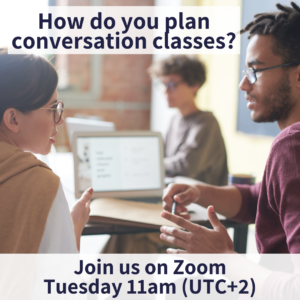This morning we were joined by the fabulous Rachael Roberts of Life Resourceful who shared her social media know-how with us. We’d had some great questions come in ahead of the chat and some other popped up during the session as well.
Is it better to focus on a particular market?
Rachael has experience of niching and says that it’s a good choice as you can focus on the areas of ELT which you particularly enjoy. It makes you more memorable and more referable. She says that a danger of trying to appeal to everyone is that your message gets lost, whereas if you focus on one aspect, you can market yourself on social media more easily and appeal to people in a specific context. That said, she added that this doesn’t mean that this becomes ALL you do. Many ELT professionals enjoy the variety of working with different age groups or in different areas and choosing to market yourself in a particular way doesn’t mean that you have to give anything else up. Similarly, if you find that you’ve ‘fallen into a niche’ and are trying to climb out of it, rebranding yourself through social media can be a great way of reestablishing yourself.
Is it true that to succeed in business on social media you either need lots of money or lots of time?
The feeling here was that time is more important than money. Although you can pay to boost posts or turn posts into ads, ads only work well if you have organic growth. Rachael mentioned that a social media marketeer had said that you need to be investing at least £300 a week to see any significant impact on Facebook.
Another approach is paying people to create content for you. This might not be the best idea if you’re trying to market yourself: you need to be authentic so that clients – whether that’s students or publishers – know what they’re getting. There are lots of tutorials you can find about setting up your own website, how to write a blogpost, what image sizes work best on different platforms and learning to do it yourself will be better in the long run. Furthermore, if you’re using Canva, you can select to create an image which is the right fit for different platforms and if you have the Pro version, it will resize content for you.
So, time is the best option. Rachael suggests being strategic and focussed: going into your social media profile to do that one thing and then get out again, rather than getting stuck scrolling for an eternity. She also has a handy hint about how to be more visible, such as the ‘juice and boost’. Deliberately don’t reply to all comments on a post in one go, but instead respond to a couple, then go back a couple of hours later and reply to more, and so on.
Consistency vs. flexibility
It’s better to get into the habit of being active on social media: posting twice a week regularly is better than have a full-on month of posts followed by a month of nothing. In terms of what you post, it’s a good idea to plan content as trying to think of what to post each time you do will end up taking your more time.
Some people like to batch content and spend a chunk of time once a month to prepare all their content, which can be a more efficient way of working.
What about scheduling posts?
This is also a time-saving option. However, it’s better to schedule your posts directly through the platform rather than using a third-party tool such as Hootsuite. This is because the platform recognises that you’re not on it to schedule content and so reduces the reach of your posts.
Do I need to vary the content for different platforms?
A social media guru would say ‘yes’. However, Rachael suggests a better approach is to focus on using one or two platforms and ensure that you’re sharing quality content on each. In terms of identifying which platform is right for you, it’s important to think about the audience you’re trying to sell to and another hint here is to make use of as many features that the platform offers as possible. For example, to be more effective on Instagram, use reels, stories and IGTV as well as the platform is moving away from being just a ‘square photo-sharing app’.
Another aspect to think about with different platforms in the life of a post. Posts on LinkedIn have a long life, whereas Instagram is a much more ‘in the moment’ platform. An additional plus of sharing content through LinkedIn and Facebook is that when someone comments on a post, it becomes visible again. There was also a question around sharing content in groups and Rachael’s advice here is to look at the type of posts in the group and the group rules: in some groups there are lots of posts of people ‘selling’ themselves, whereas in other groups this happens less.
*As an aside, in the Hub group on Facebook, we’re more than happy for people to promote themselves and what they’re doing as long as posts have a question to encourage members to reflect and engage with the content 😁
Another tip from Rachael is to ensure that the post itself is engaging. This is not only important in terms of getting people’s attention, but also because linking to an external source (such as a blogpost) reduces reach. A couple of ways around this are to post a link to your blogpost in the comments or apparently you can trick the algorithm if you post and then edit the post to include the link.
What about the analytics?
You can learn A LOT about post reach, engagement and more. However, not all of the data may be relevant to you. For example, for some people it might be more important to know where followers are based so they can identify what sort of content will be mor relevant; other people might be interested in knowing the time when most people engage with their posts; other people might want to know how people come to their site…and so on.
One thing Rachael suggests looking at is the engagement and reach and working out the engagement by reach rate. This is the total engagement (likes, comments, shares) divided by reach times 100. Apparently the average engagement by reach is about 2% so any more than that and you’re doing well!
You can then start to think about why a particular post does better than others: was it the design? the content? the humour?
‘Done is better than perfect’
This was an idea that Rachael came back to a couple of times during the Q&A. We chatted a little bit about getting over the fear of ridicule and not bothering to do hundreds of takes of a video before posting. People also mentioned that although it can be scary to put yourself out there at the start (in terms of posting video content or selfies), it does get more comfortable. One tip for producing video content was to use Filmora which is user-friendly video editing software. Rachael highlighted as well that images with your face will often do better as people like to put a face to a name. Another tip here is around brand consistency and Rachael suggests picking a few templates rather than re-inventing the wheel each time you create content. She added as well that colour branding can be quite impactful and make your posts stand out as someone’s scrolling through.
SOS!
If you’re interested in learning more, Rachael has a few spots left on her next Switch off Stress, Switch on Success programme starting in September.
During the 12-week course, you’ll look at a variety of different aspects of business management, such as niching and pinning down your message, building an effective social media profile, identifying the client journey, selling in a way that makes you feel comfortable, negotiating and much, much more. There are weekly input sessions, group coaching sessions and a supportive community channel on Slack.
